
3S is the abbreviation for “Seiwa Scholars Society,” which consists of the past and current Inamori Research Grant recipients. The 3S has evolved since 1997 with the hope that the interactions among the various specialties of the 3S members can lead to the further development of the research of their own. In the series “Visiting 3S Researchers,” we interview researchers in 3S who are very active in a variety of fields. The 10th interview is with Dr. Masaya Oki (2008 Inamori Research Grant Recipient) from the University of Fukui.
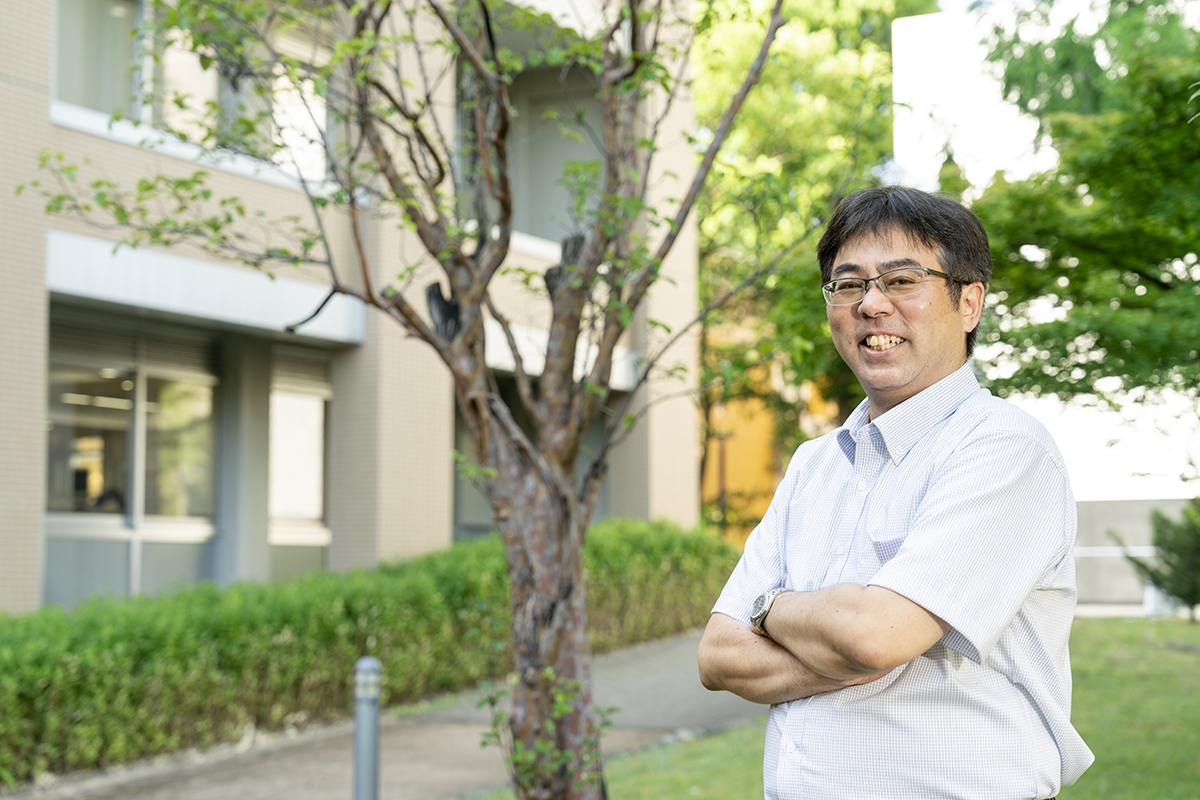
So striking is the recent technological evolution in life science that mechanisms of life that were previously unknown are being elucidated one after another. Professor Masaya Oki of University of Fukui Graduate School of Engineering has assembled an original system using yeast to zoom in on a vital phenomenon known as epigenetics. We had the pleasure of visiting Professor Oki at his laboratory to get briefed on his research in greater detail.
── Would you be kind enough to tell us about epigenetics, the subject of your research?
Dr. Oki (title omitted below) You are born with a pre-determined DNA base sequence, the basic blueprint of life, and it will remain more or less unchanged throughout your life. Also, in the case of a multicellular organism like humans, one fertilized egg develops through cell division by replicating DNA, which is why any cell in any part of the body shares the same DNA. The DNA may be the same, but how a cell regulates the way it uses genes on the DNA differs from one cell to another. Because of this, we have so many different cells with diverse functions, such as brain cells and lung cells.
Whatever happens on a cellular level will affect the entire body of the individual. The fact that identical twins, who have exactly the same DNA, grow into different persons with completely different personalities is because of the accumulation of differences in how their genes are used.
This phenomenon of regulating the use of genes after birth is called “epigenetics,” which is coined by adding the Greek prefix epi-, meaning “beyond,” “above,” or “outside,” to the term “genetics,” which relates to the study of genes.
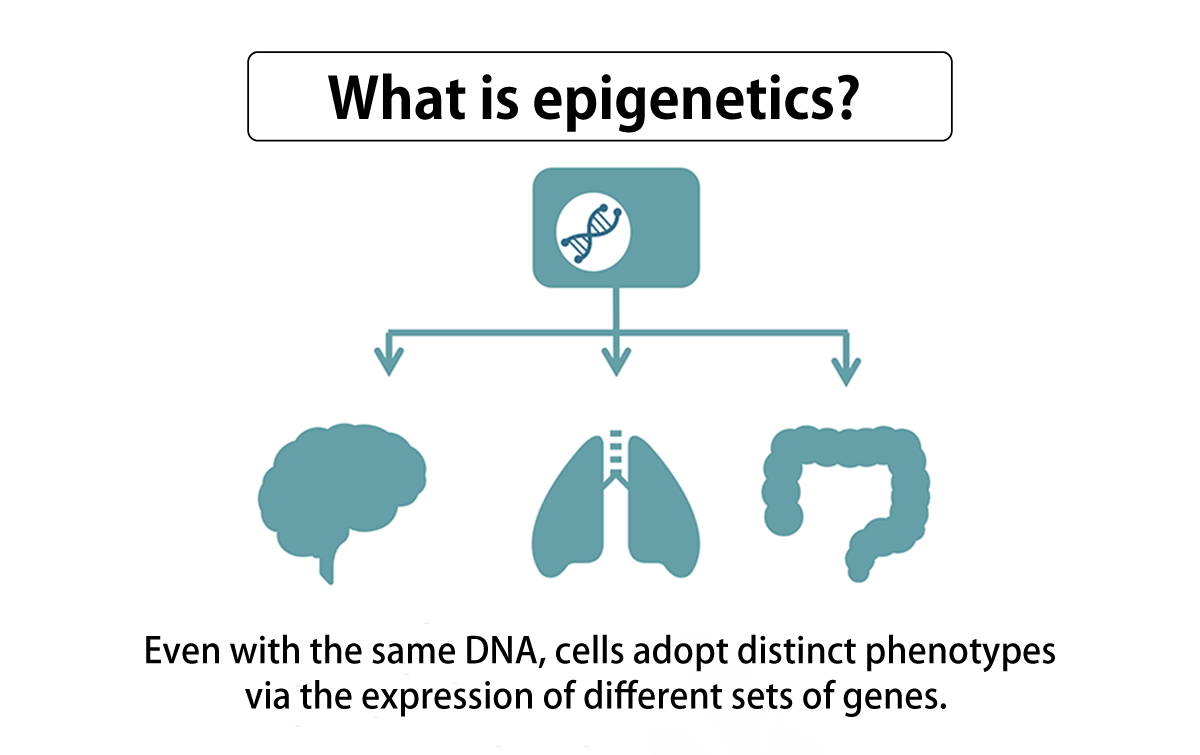
Oki Epigenetics not only determines the roles of cells but is also relevant to diseases. Once the epigenetic mechanism that causes a certain disease is understood, we can treat it with drugs. Epigenetics is not an irreversible change like DNA mutation, meaning it is a suitable target for treatment.
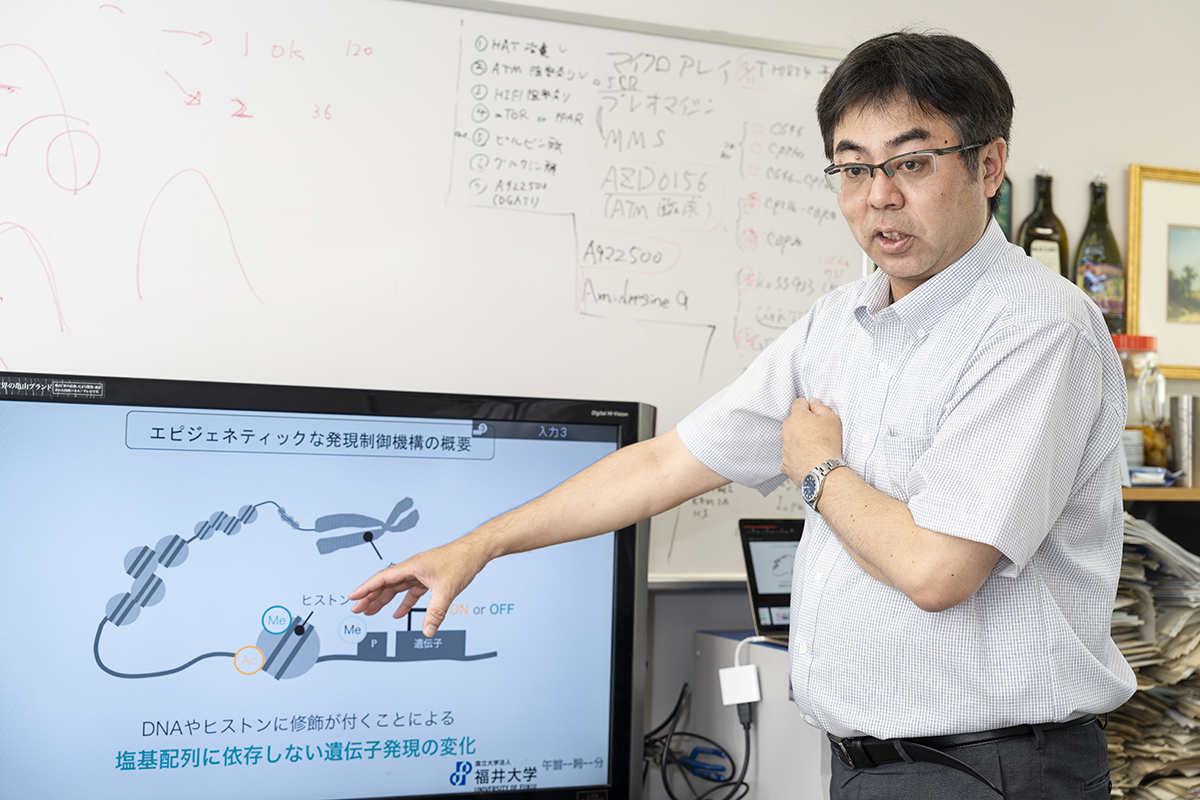
── What approaches do you take in your research?
Oki What attracts my attention toward epigenetics is its process. Epigenetics is regulated when, for example, a small organic compound called a methyl group is added to DNA or histones around which DNA is wound. In the chemical world, this process of adding small chemical substances to slightly alter the properties of an original substance is called “modification,” but little has been elucidated about when modification takes place.
To really understand what epigenetics is and apply the findings to disease treatment, it is important to capture a process where we can intervene, not when alteration has been completed. Because of this, we developed an original system that uses yeasts to allow us to observe the epigenetic process as it occurs.
Shown below are photographs of yeast cells multiplied from a single cell of yeast, all sharing the same DNA. We modified their genes to emit fluorescent green light when certain genes are expressed. The left photo shows that all the cells emit fluorescent light similarly, but, as you can see, some do and others don’t in the right photo. This is because we regulated epigenetics differently between them. If we utilize this experimental system effectively, we can learn under what environments and conditions genes we want to examine express, allowing us to narrow down conditions under which epigenetics is regulated.
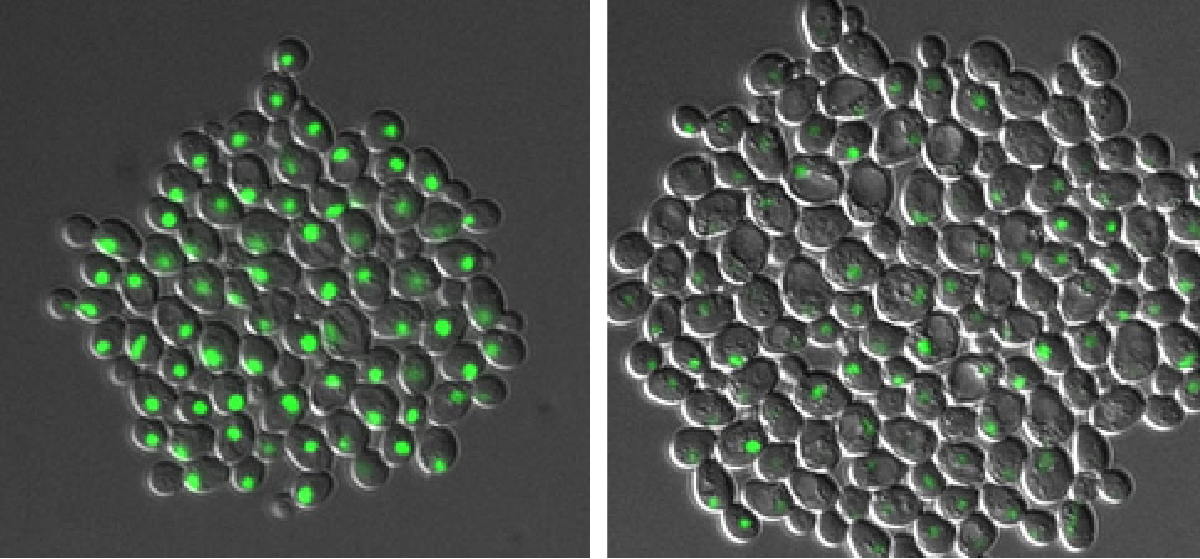
── Why did you choose to use yeasts?
Oki Yeast is a small, single-celled organism, but it is a eucaryote, just like us. Because its basic phenomena of life are similar to those of humans, its research has revealed a number of basic phenomena of human life, such as cell cycling, aging, and autophagy. The mechanism of epigenetics is extremely complicated, and our strategy is to begin by studying a simplistic organism like yeasts and then use any research findings as leads to apply them to mice and humans.
The other reason is that yeasts have a characteristic growth process—as if budding, their portions swell to divide into two cells. The cell thus created from the bud is a new daughter cell. One of the biggest merits of using yeasts is that we can trace their generations to know when in what generation a change occurred.
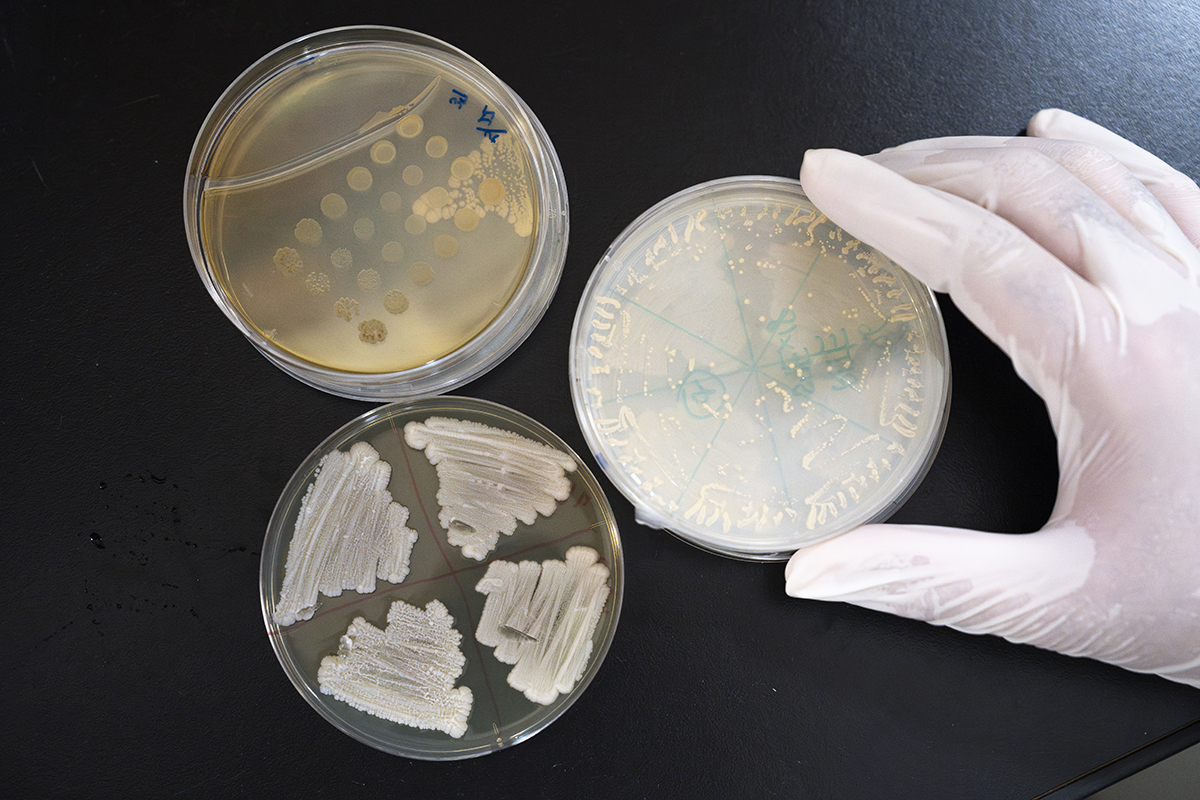
── What did the system using yeasts help you understand?
Oki Of the many things we found, there’s one that is a cut above the rest. We discovered a gene responsible for cataracts, which led to the development of a drug that prevents cataracts by controlling the gene. No one had reported that they could prevent cataracts by controlling the epigenetic expression state, and so we became the first in the world to publish such a report. In addition to preventing cataract, we also discovered a drug that treats the disease itself, for which we obtained a patent.
Cataract is a common condition that occurs in most people as they get older. In Japan, it takes a simple day surgery to treat it, but some patients are too afraid to have a scalpel in their eyes. In developing countries, on the other hand, many lose their sight because of the condition as they don’t have an opportunity to undergo surgery. Hence, it’s important to have a drug that treats it.
If you administer the drug as an eyedrop, however, the cornea blocks much of its active ingredients. So, we are also researching drug delivery to seek ways to have the eyedrop penetrate through the cornea to reach where it should. Using the same yeast system, we also discovered a remedy for retinopathy. Because it is administered into the cornea by injection, there is no drug delivery problem. We are currently working on both, and chances are that the retinopathy remedy could be made available first.
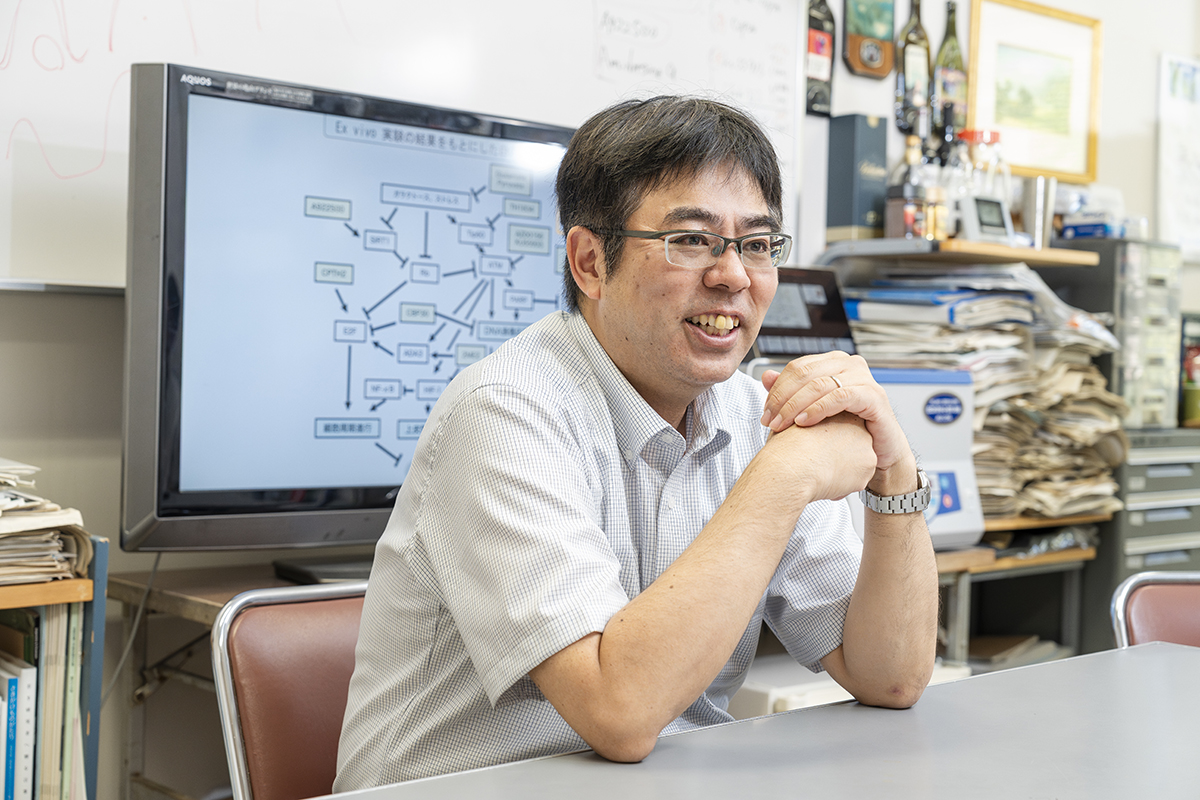
── It struck me that this yeast system could reveal a variety of epigenetic phenomena. What attracted your attention to cataracts?
Oki We did spend a lot of time choosing which diseases to select for our research. Even if we, using yeasts, should discover a gene that we can target for treatment, it would be rather hard to move on to clinical application if, say, we don’t have an animal experiment model that we can use or patients’ samples are hard to get.
Actually, I chose cataracts because of a suggestion from one of my classmates from high school, who is currently affiliated with the ophthalmology department of University of Fukui School of Medical Sciences. He read an article on my research in our university’s newsletter and e-mailed me to ask if I was interested in working with him.
Cataracts develop differently between two eyes. The difference in the progress between the right and the left strongly suggests that epigenetics has something to do with it. Also, because, during surgery, a lens is removed from the eye and replaced with an artificial one, it’s easy to collect samples. With an animal model for cataracts already existing, we had all the requirements for research met. So we decided to start the joint research.
── That’s a very unique way of starting joint research, isn’t it?
Oki True. I feel obliged to thank my university as it all started with the article in the newsletter. Working with specialists from other fields helps broaden the range of my research. I also work with a professor of information technology, who created software that incorporates image processing technology to automatically analyze the yeast system. Or I took advantage of concepts of machine learning and mathematical models to identify causal genes for certain diseases or asked an organic chemistry professor to develop a drug after we determined a treatment target. In most cases, I seek out joint research partners.
My membership in the Japan Science and Technology Agency (JST) Sakigake (Precursory Research for Embryonic Science and Technology, “PRESTO”) program has given me more opportunities to network with researchers from other fields. Often, I look for my research partners within the University of Fukui. I ask my colleagues if they know someone who can do this or that, and I meet with them if I get to know there’s one. At present, I’m trying to convince a polymer chemistry researcher to help me with my drug delivery research.
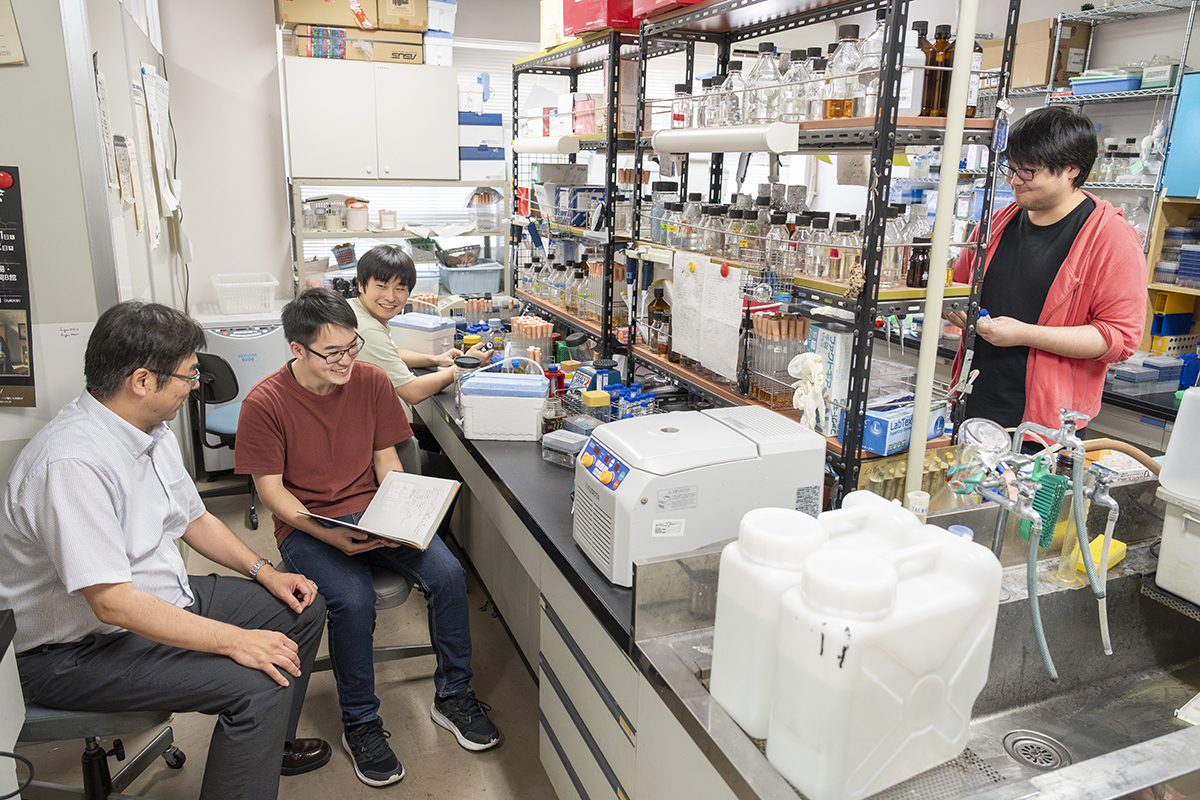
── When did you decide to pursue a research career path?
Oki Ever since I was too young to remember. I vaguely wanted to become a researcher when I grew up. My father was a university faculty member, and I often hung out at his laboratory during summer breaks.
As a child, I loved to be active, and I had long dedicated myself to badminton since middle school. But I got injured in my first year at university and had to give up badminton. At that time, a professor of a laboratory that I would later belong to invited me to help him with experiments, which I did as a freshman.
As a researcher, I am not the type to formulate theories and solve issues smartly, and rather keep my hands busy to gather a large amount of data so I can capture something that emerges in the process. In other words, I prefer unsophisticated, down-to-earth experiments. When I was a graduate school student, I used to do an enormous amount of experiments every day, only to be unable to find what I was looking for for more than a year. But I persist in this style as I cannot forget about the joy I get when I find success after such hardship.
── What do you think is the benefit of such exhaustive searching?
Oki It’s that I get to see what I didn’t expect to see at all. Chances are that doing experiments exhaustively sometimes lets me find things that I have no idea why they were sifted out in the first place. If you start with this in mind, you might get to have a completely different concept that has never occurred to you. But the downside is that it takes time and is cumbersome.
── You sound like you’re a born researcher, but what do you think you’d be doing now had you not chosen the current career path?
Oki I’ve never thought of other occupations than being a researcher, but if I had to choose one, it would be a tōji chief Japanese sake brewer. I’m a sake lover, and I love tasting locally brewed sake whenever I have a chance to travel in the country. Last month, I had the opportunity to visit Iwate Prefecture to attend a conference. With this, I’ve now been to all of the 47 prefectures in Japan! I’ve had a real variety of drinks, but I’ve never got tired of drinking, as everywhere I go, I get to find a distinct flavor.
Every brand of sake was tasty but, ultimately, I love sake from Fukui the most. Naturally, I’m biased as that’s where I’m originally from!

| By My Side |
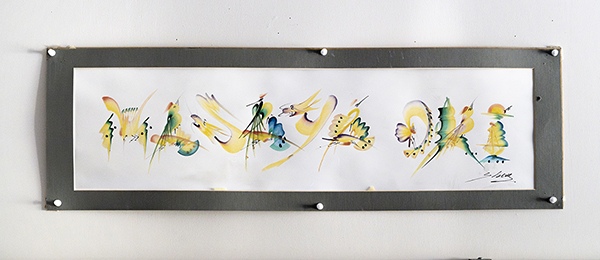 A Drawing Commissioned on the Streets of New York Done with brightly-colored birds, dragons, and butterflies, this drawing reads MASAYA OKI in the Roman alphabet. “As a researcher at the National Institutes of Health (NIH), I purchased this from a street artist in New York. It was done in a flash in front of my eyes. It was immediately after the September 11 attacks. Every time I move, I never fail to carry this with me and put it in a highly visible place in my laboratory.” |
|---|---|
| This Book |
 The Reason by Miyuki Miyabe, The Asahi Shimbun Company (Book title translated) “I was shocked to read this novel, which is narrated from different perspectives that switch between multiple persons making testimonies,” said Dr. Oki. “This changed my perception of mystery novels. I like to read and have read many such novels since I was an elementary school student. These days, I’m too busy to read novels leisurely, but I hope to write one when I’m retired.” |
Masaya Oki
Professor, Graduate School of Engineering, University of Fukui. Born in Fukui, Japan. After studying chemical and biological engineering in the Master’s Course, Graduate School of Engineering, University of Toyama, he majored in molecular biology in the Ph.D. Course, Graduate School of Medical Sciences, Kyushu University. Received his Ph.D. in Science in 1999. Then, in his capacity as an Overseas Research Fellow of the Japan Society for the Promotion of Science, he studied epigenetics at the NIH of the U.S. until he came home in 2005. Having taken positions such as Research Associate, Nagasaki University, Researcher, RIKEN, Associate Professor, University of Fukui, and JST PRESTO Researcher (concurrent position), he assumed his current position in 2018.
Interview and original article: Izumi Kanchiku (team Pascal)
Photo: Ryo Kusumoto
